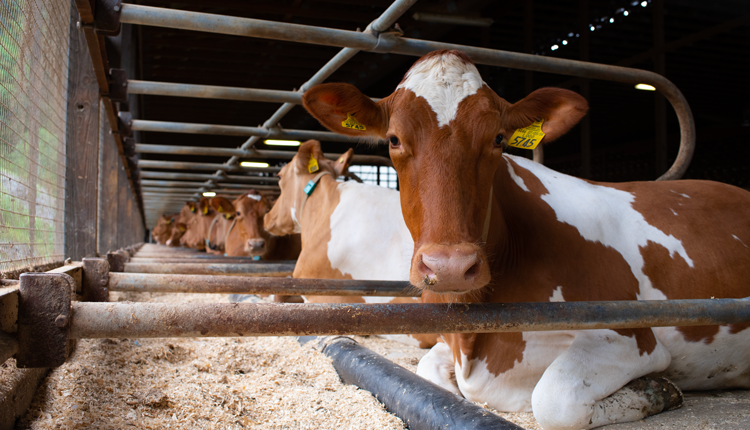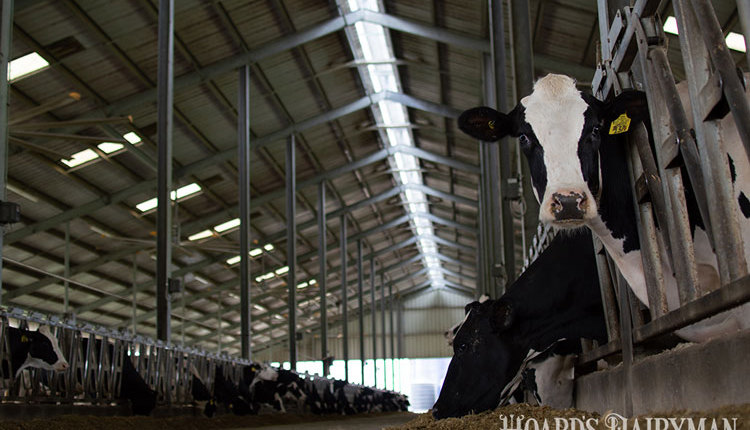The author is senior vice-president, economics, communications, and legislative affairs, Agri-Mark, Inc., Lawrence, Mass.

Milk production is beginning to outpace demand even though domestic and
international consumption remains strong. As this takes place, milk prices could soften.
This article appears in the April 10, 2012 issue of Hoard's Dairyman on page 240.

international consumption remains strong. As this takes place, milk prices could soften.
For good or bad, basic economics remain alive and well in the dairy industry. Supply and demand do eventually determine price and have combined to drive dairy product and farm milk prices lower this winter.
Recently, I have spoken with many dairy farmers who expected farm milk prices to remain strong throughout 2012. In some instances, producers have thought prices would remain high just because of the high costs of producing the milk and the fact that they could not make it any cheaper. While the cost of milk production remains elevated, in all honesty, that is essentially irrelevant to what most buyers are willing to pay for milk so long as milk supplies remain up. And it is up!
Strong flow nationwide
This unseasonably mild winter and the above-average farm milk prices of 2011 have spurred milk production in most areas of the country. U.S. milk production is now up more than 3 percent and is expected to remain strong into this spring. These gains are not isolated to one or two areas of the country as had been the case during many past growth spurts. It is widespread.
California has more milk than it can reasonably handle, and it appears several cooperatives are reimplementing past base-excess plans which assess penalties on additional milk production. Even areas of the South are reportedly having issues handling available milk. The Northeast was in good balance due to the recent expansion of Greek yogurt companies, but now milk is flowing into the region from the Midwest and elsewhere and is creating an unanticipated surplus.
Vermont is one of the few major dairy states where production is down and local milk supplies were straining to meet local demand - that is due to the crop and land damage resulting from a terrible spring and an even worse late summer hurricane. However, even those needs are now being more than met.
Current domestic demand for dairy products remains robust for some products like aged Cheddar and Greek yogurt. However, it continues to struggle in more traditional areas like fluid milk sales.
Not rising fast enough
Combined for all products, domestic demand is not rising fast enough to absorb the additional farm milk supply coming on line. Meanwhile, international demand has grown from being a minor discount outlet for U.S. surplus products a decade ago to a strong customer base representing more than 13 percent of our domestic milk production in 2011. However, last year's escalating prices slowed even that exploding demand.
In addition, milk production rebounds in New Zealand and Australia are filling those new demands in Asia and elsewhere. Long-term, the United States will be a growing source of the world's dairy products, and it would not be surprising to see 20 percent or even 25 percent of our production flowing beyond our borders eventually. However, that upward climb will likely come with many bumps in the road. 2012 may be full of such potholes.
Milk prices in 2012 are looking to average at least $2 to $3 below 2011 with farm milk prices to be the lowest of the year this spring.
Dry milk prices were particularly strong last year but have weakened significantly this winter. Nonfat dry milk exceeded $1.50 per pound at times last year and combined with $2 CME butter prices to create a Class IV price above $20 per hundredweight last summer. Since then, butter prices have fallen to the $1.40-to-$1.60 range this winter, and nonfat dry milk is sliding rapidly and could approach $1 per pound this spring.
Some sellers are even concerned that it could go to the support level of 80 cents, but that is very unlikely as buyers would step in strongly near those bargain price levels. However, combined, those newer commodity price levels could move Class IV prices to $13 per hundredweight or less.
While cheese prices have remained closer to $1.50 per pound, the important whey component of the Class III price has also eroded. At its peak above 70 cents per pound, whey powder contributed about $3 per hundredweight to the Class III price and created an other solids price of 50 cents per pound to dairy farmers under the Federal Milk Orders at its high point in January 2012. However, as such, whey prices have also fallen. They will likely be in the 30- to 40-cent range, at best, in 2012.
The Milk Income Loss Program will likely be a significant factor this year, and payment levels could approach $1 per hundredweight or higher this spring and summer. However, MILC program provisions are automatically lowered as of this September, and payment levels will fall as a result. The program could disappear entirely if not renewed under the new Farm Bill.
Time for action
As has often been the case in the past, it is really only a temporary 2 or 3 percent imbalance in supply and demand that is causing this 10 to 20 percent decline in farm milk prices. The primary goal of the Foundation for the Future (FFTF) program was to either shake out these small imbalances so farm milk prices and margins could quickly recover or else have an effective safety-net revenue program to protect farmer income during any extended periods of low prices and margins.
The Dairy Security Act currently being discussed in the House of Representatives in Congress is modeled after the FFTF program.
Some U.S. Senators are considering a similar version but with some important provisions to make the margin insurance program even more attractive to dairy farmers. More than ever, these ideas have merit and need to be part of a Farm Bill enacted THIS YEAR!








